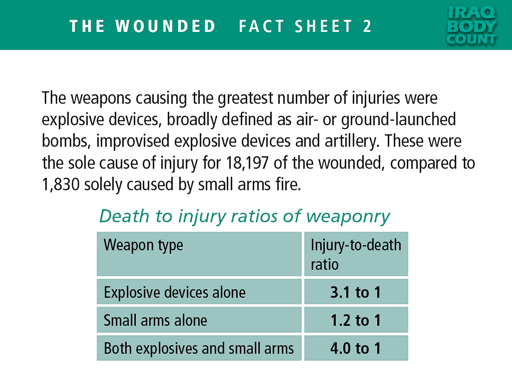In early 2006 IBC was invited to introduce its work at a Working Group Meeting on methods used by researchers to estimate armed conflict deaths (organised by the Small Arms Survey, Geneva, 17 Feb 2006).
Well-received by experts at the meeting, On Iraq Body Count summarised the project’s key features and innovations.
“The Wounded: Fact Sheet 2”
Death to injury ratios of weaponry
The weapons causing the greatest number of injuries were explosive devices, broadly defined as air- or ground-launched bombs, improvised explosive devices and artillery. These were the sole cause of injury for 18,197 of the wounded, compared to 1,830 solely caused by small arms fire.
| Weapon type | Injury-to-death ratio |
| Explosive devices alone | 3.1 to 1 |
| Small arms alone | 1.2 to 1 |
| Both explosives and small arms | 4.0 to 1 |
3.2 Analytic potentials of the data (cont.)
A second analysis looks at injuries, also broken down by type of weaponry. This shows that the ratio of injuries to deaths is far higher from bombs than from small arms. It also shows that when these are combined there is an overall increase and not a reduction in the proportion of wounded compared to incidents involving bombings alone.
One of the advantages of storing all press and media reports in an electronic database is that we were able to return to the archive and interrogate the stories for new questions we sought answers to in the 2005 dossier. Further trawls of the primary data have been commissioned from us by organisations and individuals seeking specialist information. This cannot be done unless stories are harvested and stored on a day by day basis at the time they appear.

